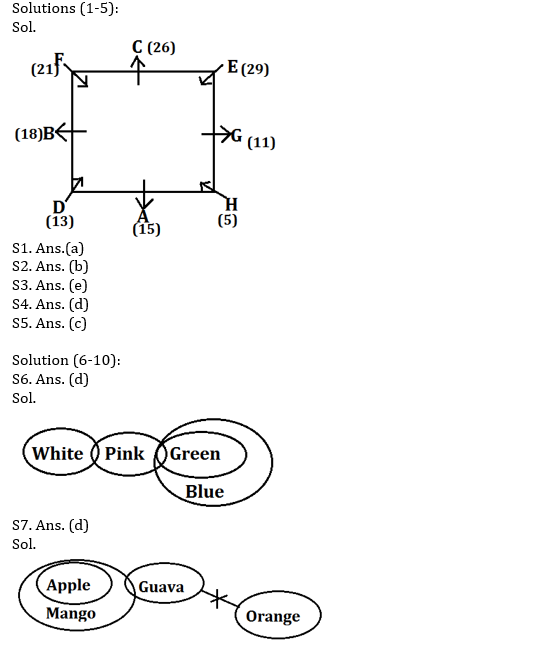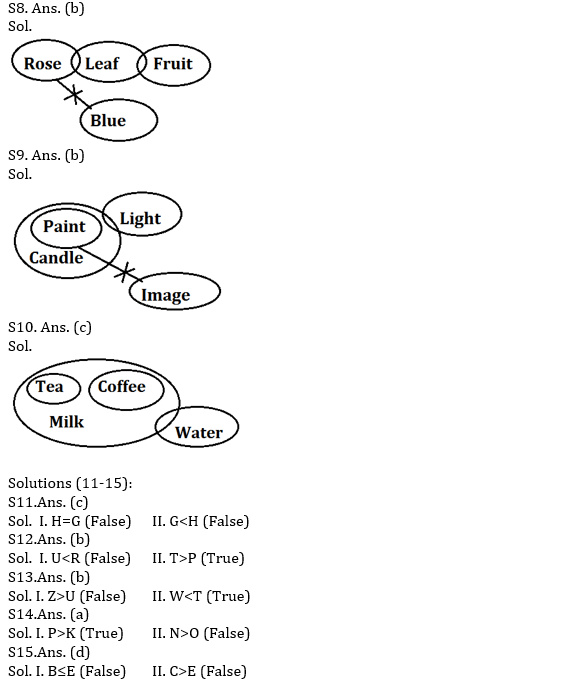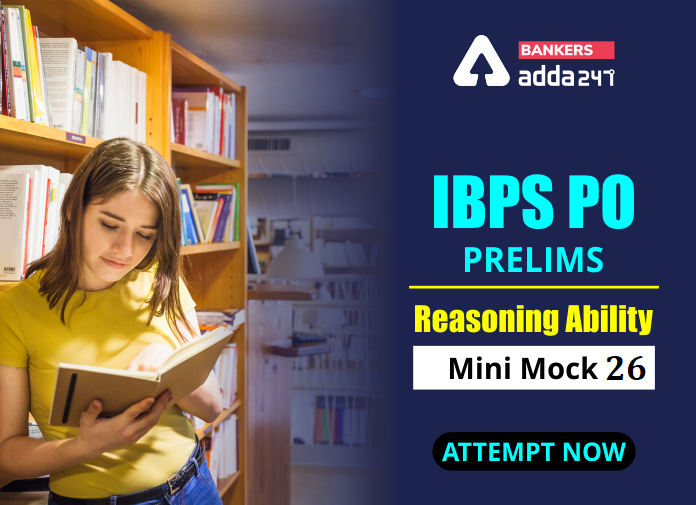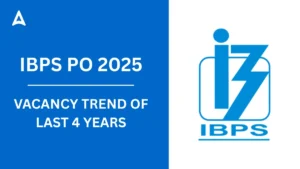Table of Contents
Directions (1-5): Study the following information carefully and answer the questions given below:
Eight friends A, B, C, D, E, F, G and H are sitting around a square table in such a way that four of them sit at four corners of the square and face inside while four sits at the middle of each of the four sides and face outside. Each of them born on different dates of the same month, viz. 5, 11, 13, 15, 18, 21, 26 and 29 but not necessary in the same order.
B sits third to the right of the one who born on 29. B born on an even date. C born on 26 and sits opposite to A. C sits immediate right to the one who born on date 29. A doesn’t sit at the corner. H sits opposite to F and the sum of the dates on which they were born is 26. Only two persons sit between F and G who born on date 11. C is an immediate neighbour of E and the one who born on 21. The difference between the dates on which C and A were born is 11.
Q1. Who sits opposite to the one who born on date11?
(a) The one who born on date 18
(b) C
(c) A
(d) D
(e) G
Q2. Who sits second to the right of H?
(a) A
(b) E
(c) F
(d) D
(e) B
Q3. If A and H interchange their positions, then who sits to the immediate right of A?
(a) F
(b) E
(c) D
(d) C
(e) G
Q4. Four of the following five are alike in a certain way and so form a group. Find the one which does not belong to that group?
(a) G
(b) B
(c) A
(d) F
(e) C
Q5. How many persons sit between A and C?
(a) One
(b) Two
(c) Three
(d) Four
(e) Five
Directions (6-10): In each of the questions below are given some statements followed by some Conclusions. You have to take the given statements to be true even, if they seem to be at variance from commonly known facts. Read all the conclusions and then decide which of the given conclusions logically follows from the given statements disregarding commonly known facts.
Q6. Statements:
Only a few white are pink.
Some pink is green.
All green are blue.
Conclusions:
I. No Blue is White
II. Some Pink is Blue.
III. All Pink is White is a possibility
(a) Only I follows
(b) Only II follows
(c) Only III follows
(d) Both II and III follow
(e) All follows
Q7. Statements:
Only mango are apple.
Only a few mango is guava.
No guava are orange
Conclusions:
I. Some apple is orange is a possibility
II. All guava is mango is a possibility
III. Some orange is mango
(a) Only I follows
(b) Both I and II follow
(c) Both I and III follow
(d) Only II follows
(e) None follows
Q8. Statements:
Some rose are leaf.
Only a few leaf is fruit.
No rose is blue.
Conclusions:
I. All Rose is Fruit is a possibility
II. Some Leaf is not blue
III. No Blue is Fruit
(a) Only I follows
(b) Both I and II follows
(c) Only III follows `
(d) Either I or III follows
(e) None of these
Q9. Statements:
All paints are candle.
Some candle is light.
No paint is image.
Conclusions:
I. All Candle is image
II. Some light is paints.
III. All image is candle is a possibility.
(a) I and II follow
(b) Only III follows
(c) I and III follow
(d) All follow
(e) None of these
Q10. Statements:
All Tea are Milk.
Only a few Milk is Water.
All Coffee are Milk.
Conclusions:
I. Few Coffee are water.
II. All tea is coffee
III. All water is milk is a possibility.
(a) I and II follow
(b) I and III follow
(c) Only III follow
(d) All follow
(e) None of these
Direction (11-15): In these questions, relationships between elements is shown in the statements. These statements are followed by two conclusions. Give answer
(a) If only conclusion I follows.
(b) If only conclusion II follows.
(c) If either conclusion I or conclusion II follows.
(d) If neither conclusion I nor conclusion II follows.
(e) If both conclusions I and II follow.
Q11. Statements: G≤F=L≤J; J≤K=H
Conclusions: I. H=G II. G<H
Q12. Statements: P<R<S<T>U
Conclusions: I. U<R II. T>P
Q13. Statements: T>U≥V≥W; X<Y=W>Z
Conclusions: I. Z>U II. W<T
Q14. Statements: K<L<M<N; M<O<P
Conclusions: I. P>K II. N>O
Q15. Statements: B<A<C; A>D≤E
Conclusions: I. B≤E II. C>E
Practice More Questions of Reasoning for Competitive Exams:
Solutions


Download PDF of this Reasoning Quiz for IBPS PO 2020
Practice with Crash Course and Online Test Series for IBPS PO Prelims:




 GA Capsule for SBI Clerk Mains 2025, Dow...
GA Capsule for SBI Clerk Mains 2025, Dow...
 The Hindu Review October 2022: Download ...
The Hindu Review October 2022: Download ...
 IBPS PO Vacancy Trend of Last 4 Years
IBPS PO Vacancy Trend of Last 4 Years





